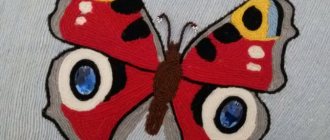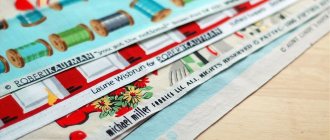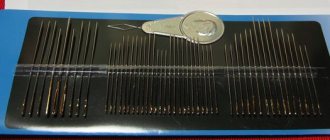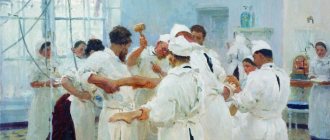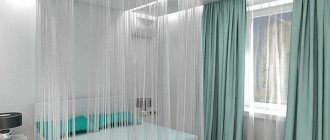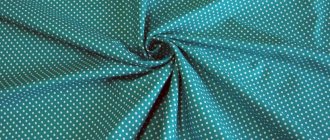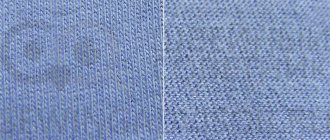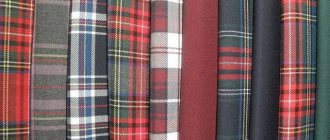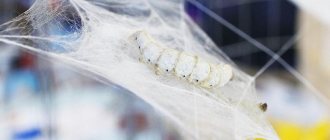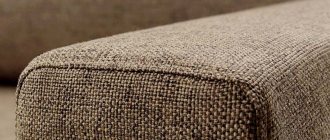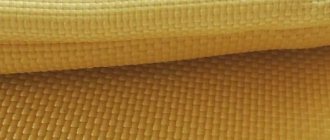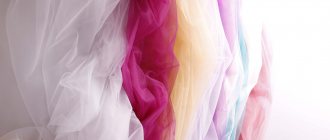Nylon thread and its types
Nylon (polyamide) threads https://www.itgf.ru/nitki_kapronovye have proven themselves better than others in the hosiery industry.
They are used in the form of monofilament (thread consisting of one elementary fiber, monolithic thread), filament thread (consisting of several continuous elementary fibers), elastic high-extensibility or high-volume low-extensibility thread (filament threads with crimped elementary fibers. In addition to hosiery production, nylon threads are used in underwear and outer knitwear production. For linen products - women's underwear, men's shirts, swimwear, smooth nylon threads are used. For outer knitted products, mainly textured nylon threads are used (high-volume and low-stretch.
The disadvantages of nylon threads include: low hygroscopicity and the associated easy occurrence of an electric charge during friction, relatively weak resistance to light (especially ultraviolet rays, which cause a decrease in the strength of the thread as a result of depolymerization). In terms of light resistance, nylon threads are similar to cotton yarn and inferior to some other synthetic fibers, for example, nitron and lavsan. On nylon hosiery, during wear, pilling is formed (rolling of balls on the surface) as a result of the breakage of individual elementary fibers.
Elastic nylon threads . Elastic nylon thread, which has high elongation, is widely used in hosiery production. It is obtained by processing filament nylon thread using the twisting method.
Other types of textured nylon threads (maron, corrugated, etc.). In outer knitwear and underwear production, marron and corrugated threads are mainly used.
Maron threads , obtained in the same way as elastic threads, from smooth nylon threads by twisting, after secondary heat treatment in a stretched form, lose a significant part of their elongation (up to 40-70%), but retain high volume. Knitted fabric produced from such threads in pure form or together with threads from other fibers acquires good properties of volume, elasticity, and increases moisture capacity compared to fabric made from smooth nylon threads. The numbers of maron threads are the same as those of elastic threads, and the characteristics of their properties differ only in the percentage of elongation. Instead of 300%, the stretchability of maron is 40-70%.
Corrugated threads , produced by mechanical corrugation (without torsion), differ from maron in the nature of the crimp of the elementary fibers of the thread, but have approximately the same characteristics of properties as maron. The most valuable property of corrugated threads is volume. Corrugation is used in the same way as maron threads for the manufacture of outerwear and linen products. The most common threads are the following thicknesses in tex (No.): 16 (64), 10 (100) and 6.8 (150).
Nitron bulk yarn bulk yarn made from polyacrylonitrile fibers (Nitron, Orlon, acrylan, etc.) in its pure form is used for the production of outer knitted products. The most popular thicknesses in tex (No.) of this yarn are 40X2 (25/2), or the original 32×2 (32/2) and 25 (40), or the original 19 (52/1)*.
This yarn is obtained by spinning from a tow using a shortened combing system. The volume of the thread is imparted by wet-heat treatment of yarn in skeins or knitted fabric after knitting. The most common is the first method of adding volume to the thread. As a result of shrinkage of one of the components of the yarn mixture - elongated polyacrylonitrile fibers, the yarn acquires high bulk (higher than the bulk of machine-spun wool yarn), but at the same time the tensile strength of the yarn decreases to the level of wool (up to 9 km). Knitted products made from high-volume twisted yarn, in addition to high bulk, they have good dimensional stability, wear resistance and other positive properties.
Nitron yarn , the volume of which is added to the knitted fabric after knitting, usually also acquires a high degree of volume, but knitted products are somewhat inferior in volume to those knitted from yarn processed before knitting. The shrinkage of the fibers elongated before spinning, constituting the so-called shrinkage component, occurs incompletely during the wet-heat treatment of the knitted fabric due to the stresses arising in the loop structure. Due to these stresses in the fiber and the bonds imposed on the thread by the loop structure, the volume of the thread becomes uneven across all cross sections, and the volume of the knitwear as a whole is slightly reduced in comparison with the method of processing free (in skeins) yarn.
According to the second method, a knitted fabric made from single-strand yarn, produced on interlock or other machines, is processed with a large length of thread in the loop so that after shrinkage the loop modulus corresponds to that recommended for a given weave. However, the volume of knitwear in this case does not reach the level obtained when using thread processed before knitting.
Polyvinyl chloride (PVC) fiber yarn . Such yarn has limited use for the manufacture of educational knitted underwear or special parts of underwear. Thanks to the high thermal insulation ability of PVC and high electrification, the knitted product is given medicinal properties for those suffering from rheumatism, radiculitis and other diseases.
Knitted fabric is not dyed due to the very low dyeability of the fiber. The low softening temperature of the fiber does not allow processing of knitted fabrics at temperatures exceeding 75°C.
How to choose threads for constructing fishing gear
Fishing threads are a key component in fishing net production. Threads are used not only as a material for making nets, but also for their subsequent repair, planting and equipping finished fishing gear. Threads made from two synthetic materials are in greatest demand among fishermen: polyamide and polyester. The features of these materials will be discussed in our article.
Excursion into history
Until the 70s of the twentieth century, linen and cotton threads were most often used for the manufacture, repair and planting of net fishing gear. The advantages of such threads include average strength combined with fairly low elongation. However, during operation, threads made from natural materials quickly became overgrown with microorganisms and rotted. In this regard, the service life of the netting was extremely short: literally within one fishing season, fishing gear became unusable.
With the advent of threads made from synthetic materials, linen and cotton began to rapidly lose their popularity. The most popular material on the domestic market for the construction and repair of fishing gear for many years has been polyamide (PA), the more common name of which is nylon. Relatively recently, threads made from a new material for the fishing industry - polyester (PES), also known as polyester or lavsan, appeared on the Russian market.
Products made from both materials are characterized by high breaking strength, excellent wear resistance and resistance to UV radiation. Today, polyamide and polyester are worthy competitors. However, in addition to the similarities, each of the materials also has its own specifics, which determine the application features and mechanical properties of the products made from them.
Shrinkage when wet - harm or benefit?
The main difference between polyester and polyamide is the high hygroscopicity of the latter. When wet, shrinkage of polyamide products can be up to 15-20%. In some cases, this property of the material creates significant inconveniences when designing fishing gear.
The predisposition of nylon to shrinkage also has its positive aspects. When knitting a mesh fabric from nylon multifilament threads, you can limit yourself to a simple single knot. During subsequent steam treatment, even single units are securely fixed. This greatly simplifies the production technology.
If we talk about the manufacture of other elements of fishing gear, such as veins in frame nets, then the use of polyamide threads is inappropriate here. Uneven shrinkage of the nylon can lead to distortion of the fishing gear and the impossibility of its further use.
Polyester is more suitable for making veins due to its zero hygroscopicity. Polyester is in demand not only in the manufacture of fishing threads, but also for the production of cords and ropes. The consumer characteristics of PES fibers make this material more promising for use in water-related industries.
In Japan, the USA, Canada, as well as the countries of the Scandinavian Peninsula, polyester threads are in first place in the construction, equipment and repair of net fishing gear. In Russian fishing, polyester threads are less popular, but industry professionals are increasingly choosing Polytex threads, made from high-strength polyester fibers.
Another type of fishing thread is Lavsan Twine thread. They are made from staple polyester. Thanks to special production technology, such threads in their structure resemble threads made from natural fibers, but are not subject to rotting. The peculiarity of lavsan threads is their fine-fiber surface, which provides excellent knot tightening.
Sewing threads
Sewing thread is a long, thin, evenly twisted yarn or thread with special properties that allow it to be used for sewing. Sewing threads are the main material for fastening clothing parts made of fabrics, knitted and non-woven fabrics, fur, leather, etc.
During operation, the thread is subjected to repeated stretching and bending, friction and abrasion (for example, against the eye of a needle and the material being joined, etc.). These effects partially disrupt the integrity of the thread and reduce its strength.
When using the finished product, the thread in the seam is also subject to various influences - insignificant in magnitude, but repeated stretching and bending; friction; exposure to detergents during washing and chemicals during dry cleaning; high temperatures and pressure during ironing. These impacts also destroy the threads in the seams. In other words, the features of sewing technology and operating conditions of finished products dictate certain quality requirements for the sewing threads selected for sewing.
Particularly strict requirements are imposed on their strength, which depends on the quality of the original yarn, the fibrous composition of the threads, their additional finishing, etc. (see below “ Properties and structure of sewing threads ”). The quality of sewing threads is regulated by standards that indicate performance standards for the most important characteristics.
Requirements for the quality of sewing threads
Sewing threads must have: - high tensile strength and sufficient elasticity (to reduce breakage on sewing machines and ensure the necessary seam strength during product use); - be uniform in thickness (also for uniform tension in the sewing machine and the formation of a high-quality seam); - have high color fastness to the effects of light weather, dry cleaning, washing; - be heat-resistant (to prevent breakage from melting of synthetic threads or overheating of natural and artificial threads, etc.). The properties and structure of sewing threads are determined by:
• fibrous composition; • number of additions; • direction of twist; • thickness; • final finishing. Based on their fibrous composition, sewing threads are divided into natural (cotton, silk, linen); chemical (polyester, polyamide, viscose); combined from various fibers (see below section “ Characteristics of sewing threads by raw material composition ”).
According to the number of folds, threads can be single-twisted in 2 or 3 folds and double-twisted in 4, 6, 9 or 12 folds. — Single-twist threads are produced by twisting 2 or 3 original individual threads. Hence their name - single-twist in 2 or 3 additions (see below Figure 1 “ Structure of sewing threads ”).
— To obtain two-twist threads, the original threads are first twisted into 2 or 3 folds. Then the resulting single-twist semi-finished products are twisted together once again completely. Depending on the number of initial components in the first and second stages of twisting, these threads are called double-twist in 4, 6, 9 or 12 folds. For sewing, the use of double-twist threads is more preferable, since, thanks to the additional fastening of the fibers when twisted, they acquire greater strength, better resist abrasion, and this reduces thread breakage when sewing a product, and the stitching is smoother. Increasing the number of plies also increases the strength of the threads. According to the direction of twist, threads have right (Z) and left (S) final twist. It is preferable to use right-twist threads, since they have less breakage in sewing machines than left-hand twist threads.
The direction of twisting the threads can be determined in this way: untwist a piece of thread with your right hand between the thumb and forefinger clockwise. If the thread is additionally twisted, then it has a twist (S), and if it unwinds, it has a twist (Z). Sewing threads are also very diverse in thickness The thickness of sewing threads is characterized by a trade (conventional) number or linear density (tex). Threads of different fibrous compositions have their own trade numbering. For example, cotton threads have trade numbers 10, 20, 30, 40 and so on; natural silk threads - 18, 33, 65; lavsan threads - 22 L, 33 L, 55 L, etc.; nylon threads - 50 K. It is important to know: for threads made of natural fibers (cotton, natural silk) - the higher the number, the thinner they are. With synthetic threads, on the contrary, thinner threads have lower numbers. And one more thing: If the thickness of the threads is the same, it is recommended to pay attention to the number of folds - the more threads are twisted, the better the quality of the threads. Depending on the type of finish, threads can be harsh, matte, glossy, white, colored, black. Bleaching and dyeing reduce the strength of threads. Glossy threads are stronger than matte threads.
Recommendations for using sewing threads 1. Regardless of whether you sew by hand or on a machine, different threads are used for each type of work (for basting, for sewing stitches, for finishing a product with decorative seams, etc.). In each case, they must be selected individually, taking into account the required strength of the seams and their purpose. General recommendations for the use of various sewing threads are given in Table 2 “ Purpose of sewing threads ” (see below). 2. To obtain high-quality stitches when sewing products, it is necessary to choose the right threads, take into account their fibrous composition and thickness. The correct choice of thread depends, first of all, on the fabric - its thickness and composition. For example, when sewing thick materials, thicker threads are used, and when sewing thin materials, thinner threads are used. The raw material composition of the threads must also be similar or similar to the composition of the fabric, since the care requirements for the selected threads and the fabric itself must match. The thickness of the sewing thread, in turn, serves as the basis for choosing a sewing needle of the required diameter: the thicker the thread, the larger the needle should be. — Threads used for sewing products must match the color of the material or be combined with it. — The threads on the spool always look darker than on the fabric. Therefore, in order to correctly determine their color, it is recommended to choose threads slightly darker than the color of the fabric. — Instead of cotton threads, it is allowed to use chemical threads and fibers of similar thickness.
Recommendations for the interchangeability of sewing threads of different compositions are given in the Table “ Interchangeability of sewing threads ”. The basis for compliance is their thickness (linear density).
“Purpose of sewing threads”
| Type of thread | Purpose of threads |
| Cotton | Manufacturing of all types of clothing |
| Silk | Making finishing stitches, loops, processing ruffles, flounces, hemming folded sections, etc. |
| Complex synthetic (lavsan, nylon) | For sewing, finishing and embroidering items made from non-shrinkable fabrics, natural and artificial leather. Making finishing stitches, loops; joining clothing parts made from materials with a high content of synthetic fibers |
| Reinforced (cotton lavsan, lavsan) | Manufacturing of all types of clothing |
| Lavsan staple | Manufacturing of all types of clothing |
| Lavsan textured | Production of knitted garments and products from elastic materials, overcasting of cuts. |
| Monofilament nylon transparent | Performing finishing and hemming stitches, processing ruffles, flounces, belts, flaps, zippers, etc. |
"Interchangeability of sewing threads"
| Cotton threads, trade number | Natural silk threads, trade number | Complex synthetic threads, conditional number | Reinforced threads, conditional number |
| 80 in 3 additions 80 in 4 additions 80 in 6 additions 60 in 3 additions | 65, 65a — — — | Lavsan 22L — — — | 20LH — — — |
| 60 in 6 additions 50 in 3 additions 50 in 4 additions 50 in 6 additions | 33, ЗЗа — — — | Lavsan 33 L — — — | Z0LH — — — |
| 40 in 3 folds | 18 | Lavsan 60L | 44LH |
| 40 in 6 folds | 18a | Nylon 50K | — |
| 30 in 3 additions 30 in 4 additions 30 in 6 additions | — | Nylon Z0K | — |
Characteristics of sewing threads by raw material composition When sewing, there should be a lot of threads - in a large assortment and with a wide choice of colors. When choosing threads, you should pay attention to their thickness and composition.
For each type of work, and also depending on the characteristics of the material, threads must be selected individually - there are no “UNIVERSAL” sewing threads. As a rule, the basis for the correct choice of threads is, first of all, their raw material composition. And one more thing: threads of different composition with the same numbers will not be the same in thickness, which must be taken into account when choosing threads. Raw material composition of threads Sewing threads are produced from natural and chemical fibers and threads. Cotton threads (cotton) are used in the manufacture of almost any type of garment, and natural raw materials make these threads indispensable in the production of clothing for children.
Depending on the finishing method, cotton threads are available in matte and glossy versions, harsh and treated with special compounds, and different colors. The most expensive option today is mercerized cotton threads.
Depending on the thickness, sewing threads are assigned trade numbers. The trade number is a conventional number of threads that characterizes their thickness. As a rule, the higher the number, the thinner the thread.
Cotton threads are produced in the following trade numbers: 10, 20, 30, 40, 50, 60, 80, 100.
The use of threads depends on their thickness. For example, threads No. 80 and No. 100 are the thinnest, so they are used for sewing products from the thinnest fabrics, and threads No. 30 and No. 40, respectively, are suitable for products made from denser and thicker fabrics. When performing manual work (for example, basting parts), it is recommended to use thin (No. 60-80) cotton threads.
Based on their strength, cotton threads are divided into the following brands: “Prima”, “Extra”, “Special”, “Especially strong”. Prima brand threads are the least durable. Threads of the “Especially Durable” trademark are used for the manufacture of workwear.
Silk threads (sewing silk) Due to insufficient strength, the range of silk threads is currently quite limited (replaced by chemical analogues). Silk threads are used mainly for finishing work and machine embroidery.
By thickness, natural silk is divided into
thin No. 65,
average No. 33,
thickened No. 13, No. 18.
Thread No. 65 is used for joining and sewing parts made of thin fabrics (for example, organza, chiffon, etc.);
for finishing stitches on medium-thick fabrics, No. 33 is suitable; No. 18
and 13 - for machine sewing buttonholes, sewing on buttons and for finishing stitches on woolen fabrics.
Linen threads
Intended for the manufacture of products for technical purposes and household consumption, for example, tarpaulin products; sewing shoes (in saddlery), making lace. Viscose threads
In appearance they are similar to threads made from natural silk. A special feature of viscose threads is their reduced strength when wet. Therefore, in the sewing industry they are used in limited quantities, mainly for embroidery. Synthetic threads
Synthetic threads are produced from polyester (lavsan) and polyamide (nylon) fibers and threads, both in pure form and in mixtures. Such threads have increased strength and low shrinkage. For synthetic threads, their conventional numbers are commensurate with their linear density (thickness).
According to the production method, synthetic threads are divided into complex, reinforced (combined), textured (voluminous, elastic), monofilament, etc.
Complex synthetic threads resemble natural silk threads in appearance. • Complex nylon threads have high strength and are superior in abrasion resistance to all other threads, so they are widely used for sewing buttonholes, as well as in the manufacture of clothes from durable, non-shrinking materials. They have a commercial designation of 50K.
The heat resistance of threads is low, so wet-heat treatment of products made using nylon threads should be carried out through a moistened ironing iron at a temperature of 160-165 ° C and for no more than 30 s. • Complex lavsan threads are also non-shrinking, but inferior to nylon threads in strength and abrasion resistance, but superior to them in heat resistance. Trade numbers: 22L, ZZL, 55L, 90L. Thin threads 22L, ZZL are used for making linen, shirts and suits and dresses, and thick threads 55L, 90L are used for embossed finishing stitching. Lavsan and nylon threads can withstand short-term heating to a temperature of 240-270°C.
Textured sewing threads (elastic) Currently, the most widely used polyester threads are textured threads (PT), which are bulky threads with loops on the surface.
Textured sewing threads are used for overcasting sections of parts, as well as in the manufacture of garments from elastic knitted fabrics. They provide strong, stretchable seams with good coverage, which is also important when processing items made from easily frayed fabrics. Thread designation: 18 LT, 24 LT, 37 LT, etc.
Reinforced sewing threads are produced by connecting a core of polyester (lavsan) filament thread and a braid of cotton (HL), polyester (LL) or siblon (LS) fiber.
Due to their combined properties, reinforced threads are universal; they are used in the sewing, knitting, footwear, and leather goods industries for stitching parts, overcasting sections and performing finishing stitches • Reinforced cotton lavsan sewing threads 36 LH, 36 LH-1, 35 LL are suitable for sewing products from thin and medium thickness fabrics, knitted fabrics; 44 LH, 44 LH-1 and 65LH, 65 LH-1 are recommended to be used instead of cotton threads of trade numbers No. 30 and 40. Threads have high strength, heat resistance, elasticity and wear resistance, as well as slight shrinkage. They are resistant to dry cleaning and washing. • Reinforced Mylar threads with a braid of Mylar fibers also provide thread seams with the required strength and wear resistance. Threads with number 35LL are used for sewing products from thinner fabrics and knitwear; 45 LL, 70 LL, etc., respectively, are suitable for denser and heavier fabrics.
Monofilament An interesting and promising range of transparent threads. They can be colorless for processing light-colored materials and pigmented (tinted gray, brown) for dark tones.
The starting raw material for their production is polyamide (nylon or nylon), which has high elastic properties, great abrasion resistance and transparency.
Treated with special optical preparations, they are able to acquire the color of the material being processed. Therefore, when sewing fabrics of different colors, the need for frequent refilling of sewing machines is eliminated. They are produced under the numbers 7KMP, 13KMP and 20KMP. Transparent threads are recommended for sewing shirts made of polyamide fabric, women's blouses and knitted dresses in medium and light colors.
Staple synthetic threads (SS) are similar in structure and appearance to cotton threads, but they are distinguished by greater strength and less shrinkage. They are softer than complex ones and more resistant to high temperatures.
The staple thread is universal in use: 27 LSh - used for sewing thin linen, dress, silk and shirt fabrics; 40 LSh - fabrics of medium surface density; 80 LSH - leather goods. All of the above types of threads are not a complete list of threads used in sewing production today; their range is much richer and more diverse.
§ 3. Threads made of synthetic fibers
Nylon threads
Nylon threads were initially introduced into the production of welted shoes. In the process of using nylon threads, their advantages over linen threads were revealed. With equal thickness, nylon threads are 1.5-2.0 times stronger than linen threads; elongation at break of nylon threads reaches 20-22%, i.e. it is 6-7 times higher than linen threads. Nylon threads are much more resistant to repeated mechanical stress (bending, stretching, abrasion) than linen threads. Nylon threads are resistant to moisture, acids, alkalis, oils and fats, microorganisms; They are practically completely frost- and heat-resistant, since they do not change their properties in the temperature range from -70° to +160° C. These threads provide good seam tightening, uniform stitching, a beautiful appearance of the seams and their high wear resistance. The listed features predetermine the widespread use of nylon threads in the shoe industry, especially for sewing on welts and soles, and to a lesser extent when assembling blanks.
Nylon threads are made by double twisting; The initial twist is given in the Z direction (right), and the final twist is in the S direction (left). The use of threads of the opposite final twist (Z) as a bobbin (needle) thread in the operation of attaching soles leads to unwinding of the threads, the formation of loops and increased breakage.
Nylon threads, like linen ones, until recently were numbered according to the metric numbering system, i.e., depending on their total thickness, they were assigned a number showing how many meters of thread are contained in 1 g
.
Thus, for example, No. 2 sewing nylon threads means that 1 g
contains
2 m
.
For sewing on welts, the thickest nylon threads are used - No. 1, 3, formed by the initial twisting of 6 strands and the subsequent twisting of 4 resulting threads. To attach soles to welts, threads No. 1, 8, formed by successive twisting of 6 strands and 3 resulting threads, are used as bobbin threads, and bobbin threads No. 2, 0, formed by the initial twisting of 5 strands and subsequent twisting of 3 resulting threads, are used as bobbin threads.
Nylon threads No. 2.4-5.5 are used when assembling yuft shoe blanks. Sewing nylon boiled and dyed threads No. 21.3 (from threads No. 64 in 3 folds) and No. 16 (from threads No. 64 sequentially in 2 and 2 folds) are used when assembling chrome shoe blanks. Total thickness and weight 100 m
nylon threads No. 21.3 (64/3) are very close to sewing cotton threads No. 40, and nylon threads No. 16 (64/2×2) are similar to cotton threads No. 30, but significantly exceed the latter in strength and ductility.
Test methods for nylon threads and standardized analytical indicators are basically the same as for flax threads. Characteristics of the physical and mechanical properties of nylon threads are given in table. 27.
Table 27. Physical and mechanical properties of nylon threads
The grade of nylon threads No. 1.2-5.5 is determined by the value of the breaking load; Class II includes threads that have reduced strength compared to established standards. Knots, falling turns and other defects are not allowed in nylon threads.
Threads No. 1.2-2.4 are produced wound in a cross winding on cylindrical wooden spools; The weight of the reel must be at least 400 g
. The bobbin should not have more than 3 ends.
Sewing nylon threads are wound on hard paper sleeves. Thread weight on package - 50, 100, 150, 200 and 250 g
. The weight of threads on individual packages may vary downwards by up to 5%; in this case, the average weight of threads in 50 packages must correspond to the norm.
The following are not allowed in nylon sewing threads: dirty and oil stains, lack of coloring, different shades, stripes, the presence of more than three knots per 1000 m
threads and some other defects.
Lavsan threads
Lavsan threads are intended for assembling chrome shoe blanks. They are made from lavsan yarn No. 34 (according to metric numbering) in 2 folds, i.e. with a thickness of 30 tex × 2
. In thickness, these threads are close to cotton sewing threads No. 30, but are much stronger than the latter and have a higher elongation at break. The specifications for lavsan threads establish the following standards for the physical and mechanical properties of the original yarn for the manufacture of these threads: the breaking load of a single thread is not less than 15 and the elongation at break of a single thread is not less than 9%.
Sewing lavsan threads are produced in spools or skeins. Thread weight in spools - from 40 to 150 g
, in skeins - from 80 to
120 g
.
In Dacron sewing threads, thread skipping, oil stains, corkscrew, thread contamination, visible under-twisting or twisting are not allowed.
The use of lavsan sewing threads, as well as nylon threads, leads to a significant increase in the strength of sewing fastenings of shoes and improves their performance properties.
